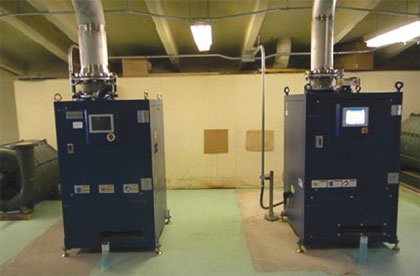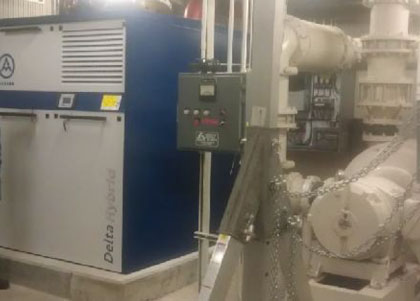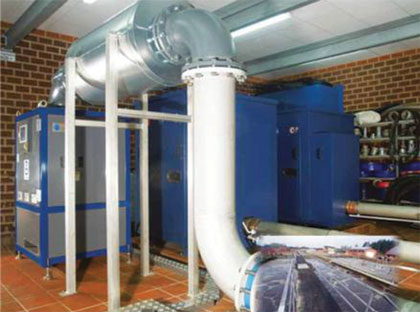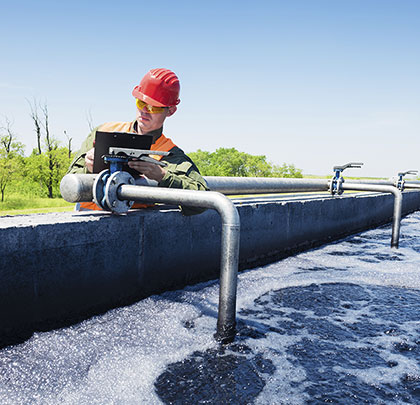In the first part of this series, we examined turbo, hybrid, and combination blower technologies and addressed the most effective technology for particular applications. In this article, we will take a closer look at case studies illustrating these three technologies and the results that can be achieved by implementing them in wastewater treatment plants. After seeing the results in action, most wastewater professionals feel more confident in making their next blower selection the right one to fit their needs.
WASTEWATER TREATMENT PLANT APPLICATION EXAMPLES
The following case studies illustrate results that can be achieved by implementing turbo, hybrid, and combination blower technologies in wastewater treatment plants.

Aerzen TB100 turbo blowers at the Blue River Wastewater Treatment Plant (Silverthorne, Colorado)
Turbo Blower: Blue River Wastewater Treatment Plant
Overview: Built in 1974, the Blue River Wastewater Treatment Plant in Silverthorne, Colorado, provides wastewater services to the communities of Silverthorne, Dillon, Dillon Valley, Buffalo Mountain, and Mesa Cortina. A conventional activated sludge plant with extended aeration capabilities and a design capacity of 4 million gallons (15.1 million liters) per day, the Blue River Wastewater Treatment Plant serves resort communities with high variation in usage, both seasonally and between midweek and weekends during the peak season.
Average demand ranges from approximately 1.5 to 2 million gallons (5.6 to 7.5 million liters) per day. Given the variation in basin levels and the limitations on turndown in the multistage centrifugal blowers, the plant operators were frequently overaerating, resulting in energy loss and lowered overall blower efficiencies. Engineers experimented with adding VFDs to the old blowers to reduce energy consumption, but it proved difficult to protect the centrifugal blowers from surge.
Objective: Reduce rising energy costs and replace the aging multistage centrifugal blowers with new technology that would reduce energy consumption and provide steady and reliable operation.
Results: The Silverthorne-Dillon Joint Sewer Authority (JSA) selected the Aerzen TB100, a 100-horsepower turbo blower for its ability to meet the plant’s maximum design aeration requirements of 1400 cubic feet (39.6 cubic meters) per minute at a pressure of 7.5 psi. The TB 100 runs on a permanent magnet motor specifically designed for the high frequency and high speed requirements of a direct drive turbo application.
An immediately apparent benefit was the drastic reduction in noise, eliminating the need for hearing protection. The plant has averaged 20 percent greater energy efficiency than with its predecessor blowers, which translates to annual savings of approximately $6500. Another energy benefit is the heat recovery from the blower’s cooling system. The warm air is used to heat the facility during the cold winter months, and a separate cooling air connection vents the heat outdoors during the summer months. Since the blowers use airfoil bearings that are lubricated by air instead of oil, the plant has also reduced its maintenance costs.

The City of Anacortes replaced a 125 horsepower multistage centrifugal blower with an Aerzen D 62S 75 horsepower hybrid blower
Hybrid Blower: City of Anacortes Wastewater Treatment Plant
Overview: The City of Anacortes WWTP is located in the state of Washington off the coast of Puget Sound, which is home to a variety of wildlife and aquatic life. Its WWTP processes 2 million gallons (7.5 million liters) per day and was using three 150 horsepower multistage centrifugal blowers with a minimal air flow rate of roughly 1750 standard cubic feet (49.5 cubic meters) per minute—far more than required to maintain adequate dissolved oxygen (DO) in the basin.
Objective: Improve efficiency of the aeration system and reduce operating costs and energy consumption/costs by investing in more efficient blower technology.
Results: After evaluating hybrid and turbo technologies, the plant selected the Aerzen Delta Hybrid model D 62S with a 75 horsepower motor for two reasons: (1) lower initial and operating costs and (2) broad range of operating conditions, specifically greater turndown capacity. The new Delta Hybrid operates between 1450 standard cubic feet (41 cubic meters) per minute at peak flow and 600 standard cubic feet (16.9 cubic meters) per minute during the night, for a power savings of 30 to 55kW.hr, depending on the time of day.
The new blower also enabled the plant to turn off two channel air blowers, which alone saved approximately $11,700 per year. All told, the new aeration system saved the city approximately $56,155 per year in energy costs and demand fees, which their utility provider charges industrial customers based on consumption. Payback was achieved in twenty-two months. In addition, the plant was able to use existing maintenance staff to service the new aeration blowers, eliminating the potential costs associated with service and maintenance agreements.

Aerzen AT turbo blower and two PD blowers processing air at a Bremervörde, Germany sewage treatment plant.
Combination Blower Technology: Bremervörde Sewage Treatment Plant
Overview: The Bremervörde sewage treatment plant in Germany has an overall design capacity of 30,000 Einwohnergleichwert (EGW, or population equivalents)—a measurement of the total pollution load divided by the individual pollution load of one person. Operating at approximately 29,000 EGW, the plant is nearing full capacity, processing up to 105,944 cubic feet (3000 cubic meters) of wastewater per day. However, weekend turndown can result in load fluctuation from 42,377 to 52,972 cubic feet (1200 to 1500 cubic meters). During the week, the plant processes a nearly constant 52,972 cubic feet (1500 cubic meters) per day using two existing Aerzen Delta PD blowers. Approximately 75 percent of the plant’s energy consumption goes toward generating process air, which represented a significant operating cost reduction opportunity.
Objective: Optimize energy use by implementing a fully automated blower system that would meet process air requirements within the operating range of 50 to 100 percent.
Results: The plant selected the Aerzen AT 100 turbo blower. The new turbo blower serves as a base load generator for process air, operating at a capacity range from 1200 to 2800 standard cubic feet (35 to 80 cubic meters) per minute. The two existing PD blowers are connected to the new system and automatically start when needed to handle peak loads or serve as redundant blowers. Adding the new turbo blower resulted in cost savings on the order of 20 to 25 percent.
SUMMARY AND CONCLUSION
Wastewater treatment plant managers have more opportunities to optimize energy efficiency and reduce operating costs thanks to a variety of aeration blower technologies and application concepts. A thorough understanding of the overall process, operating conditions, and interplay of aeration and process controls is key to a successful implementation. Often, technologies are misapplied due the promise of high energy efficiency, failing to consider operational variables that will ultimately cause the machine to run outside its intended range. New concepts of applying established and more recent technological advances within the context of the entire wastewater treatment plant system have proven effective in maximizing the benefit of each technology. The result is an improvement in the overall operating efficiency of the wastewater treatment plants in terms of overall equipment effectiveness (OEE), energy efficiency, and reduced operating and maintenance costs. ■
About The Author
Aerzen USA offers a wide array of positive displacement blowers, high-speed turbo blowers, screw compressors, rotary lobe compressors, and vacuum pumps for various industries. For more information, visit www.aerzenusa.com.
MODERN PUMPING TODAY, February 2015
Did you enjoy this article?
Subscribe to the FREE Digital Edition of Modern Pumping Today Magazine!


